 If you see winter moths this November or December, we’d like to hear from you using the survey below. The information you provide will be used to assess the distribution of this invasive pest in our state.
If you see winter moths this November or December, we’d like to hear from you using the survey below. The information you provide will be used to assess the distribution of this invasive pest in our state.
Reports are starting to come in that winter moths are flying once again in Massachusetts. Winter moth (Operophtera brumata) is an invasive species first discovered in Massachusetts in the 1990s. Winter moth caterpillars are efficient tree defoliators, often stripping the leaves of oaks, maples and other hardwood trees down to lacy skeletons.
At a time of year where insect activity is practically at a standstill, small brown winter moths can now be seen in much of the eastern part of the state, congregating at porch lights by the hundreds. There are other similar-looking native moths active at this time of year, such as the Bruce spanworm moth and the fall cankerworm moth, but they are typically not seen in such large numbers. While the state does not regulate winter moth, some towns/cities do tree treatments, and the Elkinton Lab at University of Massachusetts Amherst currently has a biological control program underway.
Helpful links:
- For more information on winter moth biology and management, see this fact sheet from UMass Extension.
- For examples of male and female winter moths and fall cankerworm moths, see this photo gallery.
- If you would like to email a photo, please use our Pest Reporting Form
November 14th, 2011 Jennifer Forman Orth
insects, volunteer, winter moth
This time of year, reports sometimes come in through our ALB reporting form from Massachusetts residents worried that they have found Asian longhorned beetle inside their homes. Most of these reports turn out to be the Western conifer seed bug (Leptoglossus occidentalis or “WCSB”), which can be confused with Asian longhorned beetle. This insect has a dark brown body about 3/4 of an inch long, alternating white and brown marks on its lower body surrounding the wings, and back legs that have a distinct flattened leaf-like shape (see photo). The Asian longhorned beetle, by contrast, has a shiny black body, like patent leather, with prominent white spots. Also, the antennae of the Western conifer seed bug are brown, and lack the alternating black and white bands found on the antennae of ALB.
Unlike Asian longhorned beetles, which overwinter as wormlike larvae deep inside hardwood trees, adult Western conifer seed bugs escape cold temperatures by seeking shelter in houses and other warm locations. At this time of year, you may find a Western conifer seed bug sunning itself on the side of your house or buzzing around a window screen, looking to escape the approaching cool weather. If you have encountered this insect pest before, you may also have had the unpleasant experience of smelling the acrid, citrusy-smelling liquid it emits when startled.
Western conifer seed bugs are native to the west coast of the USA, but have been established on the east coast since the 1990s. Unlike ALB, which is a non-native and serious pest of hardwood trees, the Western conifer seed bug is only considered a minor pest of the coniferous trees it attacks (pine, Douglas fir and hemlock). However, these bugs can be a major inconvenience if they find a way to enter your home. Small infestations can be handled by sealing up any crevices that the bugs could be using to sneak in (holes in screens, chimneys, loose window fittings, etc.) and by capturing escapees by hand or by shop vac. Larger infestations may require consultation with a licensed pest specialist.
To learn more about the Western conifer seed bug, read this fact sheet from Cornell University. To report a potential sighting of Asian longhorned beetle, click here. To see a gallery of ALB Look-alikes, download our guide.
October 26th, 2011 Jenn Forman Orth
 Fall is in full gear, and for many people that means it’s the start of the holiday decorating season. This is a reminder to be aware that Asiatic bittersweet and multiflora rose, two invasive species, are sometimes used to make holiday wreaths, garlands and other decorations. These plants are on the Massachusetts Prohibited Plant List and are not allowed to be sold in our state. Wreaths and other decorations made with invasive plants can lead to new infestations when the fruits from the plants are spread onto the soil or carried by birds or other animals that eat the fruit. For more information, see our previous blog post “Invasive plants in holiday decorations.” To report the sale of these or other invasive species in Massachusetts, see our online reporting form.
Fall is in full gear, and for many people that means it’s the start of the holiday decorating season. This is a reminder to be aware that Asiatic bittersweet and multiflora rose, two invasive species, are sometimes used to make holiday wreaths, garlands and other decorations. These plants are on the Massachusetts Prohibited Plant List and are not allowed to be sold in our state. Wreaths and other decorations made with invasive plants can lead to new infestations when the fruits from the plants are spread onto the soil or carried by birds or other animals that eat the fruit. For more information, see our previous blog post “Invasive plants in holiday decorations.” To report the sale of these or other invasive species in Massachusetts, see our online reporting form.
October 18th, 2011 Jennifer Forman Orth
bitter, invasive plants, plants
 UMass Amherst is reporting that Extension entomologist Joe Elkinton now has evidence that the biocontrol for the invasive winter moth has finally taken hold in Massachusetts. For the past 6 years, Elkinton’s lab has been rearing and releasing a parasitic fly, Cyzenis albicans, that attacks the invasive winter moth (Operophtera brumata). Research shows that fly releases in towns including Falmouth and Wellesley, MA have created established populations in some of the most heavily impacted winter moth sites in the state. That’s good news for eastern Mass., which has seen repeated defoliation and eventual loss of trees due to winter moth infestations.
UMass Amherst is reporting that Extension entomologist Joe Elkinton now has evidence that the biocontrol for the invasive winter moth has finally taken hold in Massachusetts. For the past 6 years, Elkinton’s lab has been rearing and releasing a parasitic fly, Cyzenis albicans, that attacks the invasive winter moth (Operophtera brumata). Research shows that fly releases in towns including Falmouth and Wellesley, MA have created established populations in some of the most heavily impacted winter moth sites in the state. That’s good news for eastern Mass., which has seen repeated defoliation and eventual loss of trees due to winter moth infestations.
October 5th, 2011 Jennifer Forman Orth
insects, moths, research, winter moth
 Do you know how to recognize the signs of an Asian longhorned beetle infestation? Early detection of invasive species can be the key to preventing their spread, and our state’s trees need your watchful eye. In August of 2008, an infestation of the invasive Asian longhorned beetle (“ALB”) was found in Worcester, MA. That infestation, found over a decade after it started, is now the largest in North America, and has caused the loss of 30,000 trees. When an ALB infestation was found in Boston in 2010, it was only 2 years old, and so far only 6 trees have had to be removed.
Do you know how to recognize the signs of an Asian longhorned beetle infestation? Early detection of invasive species can be the key to preventing their spread, and our state’s trees need your watchful eye. In August of 2008, an infestation of the invasive Asian longhorned beetle (“ALB”) was found in Worcester, MA. That infestation, found over a decade after it started, is now the largest in North America, and has caused the loss of 30,000 trees. When an ALB infestation was found in Boston in 2010, it was only 2 years old, and so far only 6 trees have had to be removed.
Join the Emerald Necklace Conservancy and the Massachusetts Department of Agricultural Resources Saturday, Sept. 17th 10am-12pm for an Asian longhorned beetle “Walk and Talk” at Franklin Park in Boston. We’ll start with a short training session about the beetle and how it damages trees, and then show you how to do a ground survey of host trees using binoculars. To register for this event, contact volunteer@emeraldnecklace.org.
August 23rd, 2011 Jennifer Forman Orth
Asian longhorned beetle, insects, volunteer
 Over the past few weeks staff at the Mass. Dept. of Agricultural Resources, the Dept. of Conservation and Recreation, and volunteers have been scouting out Cerceris wasp colonies for the Wasp Watchers project, where we monitor non-stinging wasps that are experts at hunting the invasive emerald ash borer beetle. The project was recently featured in this Boston Globe article. A lot calls have come in offering information on potential wasp nesting sites, and the assistance is greatly appreciated! Here’s a reminder of what to look for:
Over the past few weeks staff at the Mass. Dept. of Agricultural Resources, the Dept. of Conservation and Recreation, and volunteers have been scouting out Cerceris wasp colonies for the Wasp Watchers project, where we monitor non-stinging wasps that are experts at hunting the invasive emerald ash borer beetle. The project was recently featured in this Boston Globe article. A lot calls have come in offering information on potential wasp nesting sites, and the assistance is greatly appreciated! Here’s a reminder of what to look for:
 Cerceris wasps are only about half an inch long, and are mostly black with a few yellowish bands. There are many other species of ground-nesting wasps in Massachusetts. The most frequently reported of these are cicada killers and great golden digger wasps.
Cerceris wasps are only about half an inch long, and are mostly black with a few yellowish bands. There are many other species of ground-nesting wasps in Massachusetts. The most frequently reported of these are cicada killers and great golden digger wasps.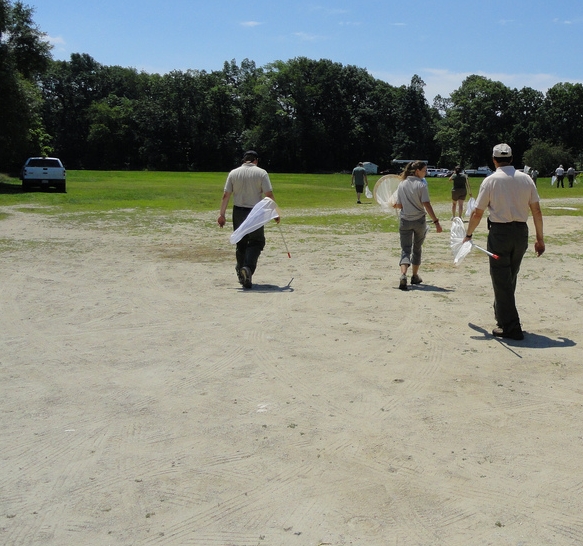 Cerceris wasps nest in hard packed, sandy soil. We scout for wasp colonies in ball fields, dirt trails, and informal parking lots. You typically won’t find Cerceris wasps in your yard…unless you’ve got a ball field back there!
Cerceris wasps nest in hard packed, sandy soil. We scout for wasp colonies in ball fields, dirt trails, and informal parking lots. You typically won’t find Cerceris wasps in your yard…unless you’ve got a ball field back there! The Cerceris wasp builds a very particular kind of nest. Look for round entry holes in the ground, surrounded by a “volcano” of soil, like an ant hill. Because of the way that these wasps dig their nests, the holes are dead center in the mound of dirt. Other wasps may dig so that the pile is off to one side, or so there is no real pile at all.
The Cerceris wasp builds a very particular kind of nest. Look for round entry holes in the ground, surrounded by a “volcano” of soil, like an ant hill. Because of the way that these wasps dig their nests, the holes are dead center in the mound of dirt. Other wasps may dig so that the pile is off to one side, or so there is no real pile at all.
Want more information? Check out our previous Wasp Watchers post.
Photos 1 and 3 by J. Forman Orth, MDAR, Photo 2 by Alexandra Echandi, DCR.
July 25th, 2011 Jenn Forman Orth
emerald ash borer, insects, volunteer
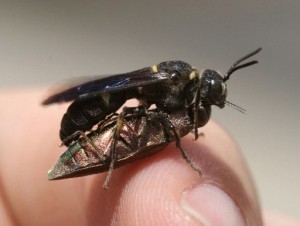 Want to help protect Massachusetts from the invasive emerald ash borer? Volunteer teams from Central and Eastern Massachusetts are needed to track the beetles, using a wasp that is an expert at finding them. Cerceris fumipennis, a native wasp species, is an expert at catching Agrilus beetles, including the Agrilus of greatest concern to us in Massachusetts: the emerald ash borer (Agrilus planipennis, “EAB”).
Want to help protect Massachusetts from the invasive emerald ash borer? Volunteer teams from Central and Eastern Massachusetts are needed to track the beetles, using a wasp that is an expert at finding them. Cerceris fumipennis, a native wasp species, is an expert at catching Agrilus beetles, including the Agrilus of greatest concern to us in Massachusetts: the emerald ash borer (Agrilus planipennis, “EAB”).
EAB has not yet been found in Massachusetts, but was discovered in New York last summer, just 25 miles away from our western border. Cerceris wasps are a valuable tool in our efforts to find EAB as early as possible. The wasps are easy to hunt for because they build their nests in sandy soil, in areas like baseball fields, parking lots, campsites and roadsides. And these wasps do not sting, even when handled.
The Mass. Department of Agricultural Resources is looking to train small teams or volunteer leaders from larger organizations to help locate new Cerceris colonies. For groups able to commit more time, volunteers are also needed to adopt sites with established colonies, in order to monitor the wasp nests and collect beetles. A training session is coming up in early July. For more information, contact Jennifer Forman Orth at jennifer.forman-orth@state.ma.us or 617-626-1735.
To learn more about using wasps to track emerald ash borer, visit cerceris.info.
June 13th, 2011 Jenn Forman Orth
emerald ash borer, insects, volunteer
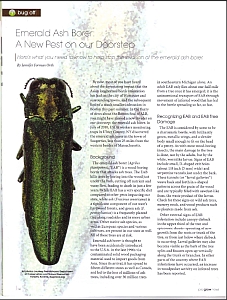 The latest issue of Pro Grow News, the Massachusetts Nursery and Landscape Association’s bimonthly magazine, features an article about the looming threat of emerald ash borer in Massachusetts. The article, “Emerald Ash Borer: A New Pest On Our Doorstep,” is written by the Massachusetts Department of Agricultural Resources‘ State Plant Pest Survey Coordinator, Jennifer Forman Orth. The MNLA has generously agreed to share the article for the public to download and read.
The latest issue of Pro Grow News, the Massachusetts Nursery and Landscape Association’s bimonthly magazine, features an article about the looming threat of emerald ash borer in Massachusetts. The article, “Emerald Ash Borer: A New Pest On Our Doorstep,” is written by the Massachusetts Department of Agricultural Resources‘ State Plant Pest Survey Coordinator, Jennifer Forman Orth. The MNLA has generously agreed to share the article for the public to download and read.
For more information about emerald ash borer, check out this fact sheet from the Mass. Introduced Pest Outreach Project.
April 28th, 2011 admin
emerald ash borer, insects
The Mass. Department of Agricultural Resources has reproduced two of its most popular handouts for Asian longhorned beetle outreach in a Spanish language format. Our ALB Tree Guide and ALB Look-alikes sheets are now both available in Spanish:
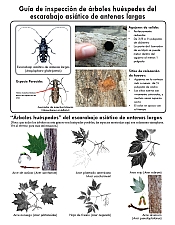
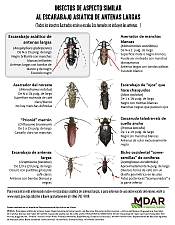
To view the entire collection of ALB outreach materials, visit the Massachusetts ALB Cooperative Eradication Program’s Media Page.
April 20th, 2011 Jennifer Forman Orth
Asian longhorned beetle, education, insects
New from the ALB Educational Outreach Development Team at the Mass. Department of Agricultural Resources:

It’s Asian Longhorned Beetle Jeopardy! Aimed at those at high school level or older, this fun version of the popular Jeopardy! game is all about the Asian longhorned beetle. Download it here.
April 5th, 2011 Jennifer Forman Orth
Asian longhorned beetle, education, insects
 If you see winter moths this November or December, we’d like to hear from you using the survey below. The information you provide will be used to assess the distribution of this invasive pest in our state.
If you see winter moths this November or December, we’d like to hear from you using the survey below. The information you provide will be used to assess the distribution of this invasive pest in our state.
 Fall is in full gear, and for many people that means it’s the start of the holiday decorating season. This is a reminder to be aware that Asiatic bittersweet and multiflora rose, two invasive species, are sometimes used to make holiday wreaths, garlands and other decorations. These plants are on the
Fall is in full gear, and for many people that means it’s the start of the holiday decorating season. This is a reminder to be aware that Asiatic bittersweet and multiflora rose, two invasive species, are sometimes used to make holiday wreaths, garlands and other decorations. These plants are on the 








